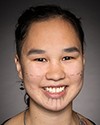Mr. Speaker, matna. For much of Canada, the 215 children found on the Kamloops residential school grounds was a shocking discovery, but for indigenous peoples this was not a discovery. This was a confirmation of the reality of genocide we have known all along.
I am glad to hear members finally waking up to what indigenous peoples already knew, but many in this chamber clearly have more to discover about the reality of the ongoing colonization of indigenous peoples across Canada. I see this every day in my riding, and I need my colleagues, Canadians and the world to listen.
Recently I spoke with a friend of mine, Nikki Komaksiutiksak. Nikki is originally from Nunavut, but moved to Winnipeg at a very young age with her mother to live with her aunt. Both her mom and her aunt are residential school survivors.
After arriving in her new home, Nikki experienced severe amounts of abuse. Eventually she ran away from home to escape the violence, but police found her and took back to her house. They thought her resistance to going home was because she was a defiant kid, so they pushed her to the front door. Nikki was so terrified of what was on the other side that she tore her clothes off to show the police her injuries. They stared at Nikki, a 13-year-old, with hundreds of whip marks and stab marks all over her body.
The police took her to the hospital, where she stayed for 24 hours, and immediately afterward she was taken to her first group home. She felt incredibly alone. Nikki was never asked what she wanted, how she felt or how she needed help. Because of this, she felt it was better to run away to be with her friends, but again she was caught by the police and put back into the system.
In just two years, Nikki was in 15 group homes. She was always running away, trying to find a sense of normalcy and feeling more and more alone. She went into foster care with her cousin, who was so close to her that they considered one another sisters. Her cousin was murdered in Winnipeg at the age of 17, and still no one has taken responsibility for her death.
Imagine even before graduating high school being tossed from home to home, not often shown love in the way a child needs and not having stability or consistency in day-to-day life.
Nikki attempted to die by suicide many times and eventually was put into a treatment centre. There, she received counselling and therapy for the first time ever. She started to learn new ways of coping and was given tools to start working toward breaking cycles of trauma. From therapy, she was eventually put into a foster home with parents who cared for her and loved her.
While in the foster system, Nikki had three babies of her own and fought to make sure they were never taken away from her. This was not easy, but she fought and she won. She eventually finished grade 12, went to university and got an amazing job where she fights to support Inuit every day at Tunngasugit. She now fosters high-risk teenage girls herself.
The story of Nikki is the story of thousands of Inuit and indigenous children across Canada. Nikki’s strength and resilience mean her children have a bright future. That strength came from her, and from her will to become better.
Colonization is not over: it has a new name. Children are still being separated from their communities. Foster care is the new residential school system. The suicide epidemic is the new form of indigenous genocide.
I come from a community with one of the highest rates of suicide. Throughout my life, I have seen periods of extreme hopelessness in Baker Lake, where there are sometimes three or four suicides in less than two months. These were my friends, teammates and classmates.
I often wondered growing up if things were changing or just getting worse, but the intergenerational trauma of the recent past has created a terrible cycle where death has become normal. For Inuit, suicide is an epidemic. We know in Nunavut that things often are not recorded or investigated correctly. Many families do not get answers. Questionable information is withheld. Questions go unanswered and ignored. Families do not have support in any way, shape or form. Often families are left to clean up the remains of their loved ones.
I have heard stories of people with no heads, of the colours they turn when they hang themselves from the ceiling and of the way it smells when someone passes away. There are often times when children and youth see much of this. However, after all of these traumatic incidents, there are not many mental health resources, let alone culturally relevant mental health resources, available to these children and these families.
Just like suicide and death, losing children to foster care is becoming the norm for Inuit families. This is a direct outcome—

